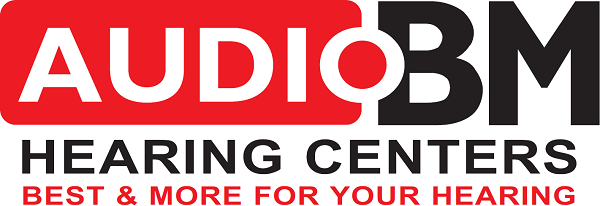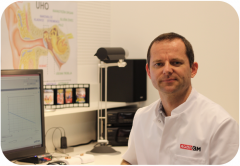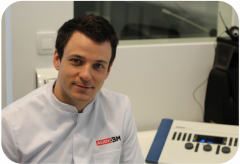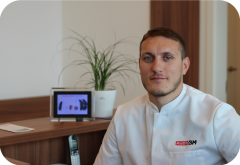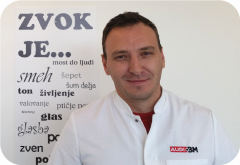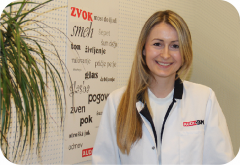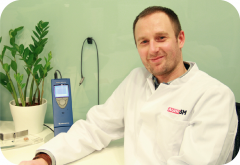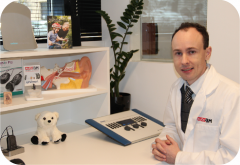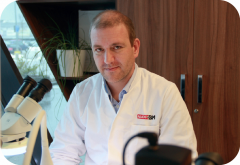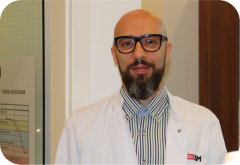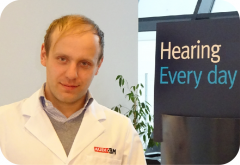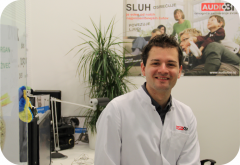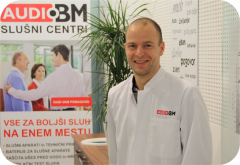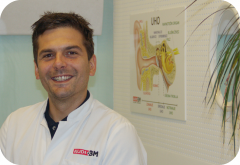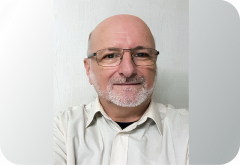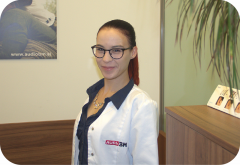Hearing acousticians about hearing aid functions
Complicated expressions for hearing aid functions explained using user friendly terms.
Our priority is to explain
how various functions affect
the quality of hearing,
what is their purpose and
how useful can they be in reality.
North, Tempus and Discover are moving borders.
Platforms Unitron North, Tempus and Discover have strong foundations with guaranteed quality of sound, directionality of natural sound possibilities and wireless connectivity is all in their hands. With great dynamical range, clear signal processing and excellently integrated algorithms the sound quality will be amazing – typical for Unitron. With platforms North, Tempus and Discover every user will take a step towards as natural sound as possible.
North, Tempus and Discover platforms are integrated into hearing aids such as Stride and Moxi.
Not even two conversations are the same
Each conversation has some sort of background noise. For that reason, Unitron decided that only one environment for clearing speech out of background noise is not enough. We need more environments based on different types of background noises so that users will be able to understand and participate in the conversation. It inspired Unitron to help hearing aids users to hear better in every possible condition.
Focused on conversations
The new automatic program SoundNav precisely detects seven different environments, four out of them are specifically focused on conversations. SoundNav works along superb technologies such as Sound Conductor and SpeechZone 2, to give the user simple and immediate chance of participating in conversations which they might have avoided before. It also allows comfort in hearing the background of quiet and noisy environments and also the pure sound of music.
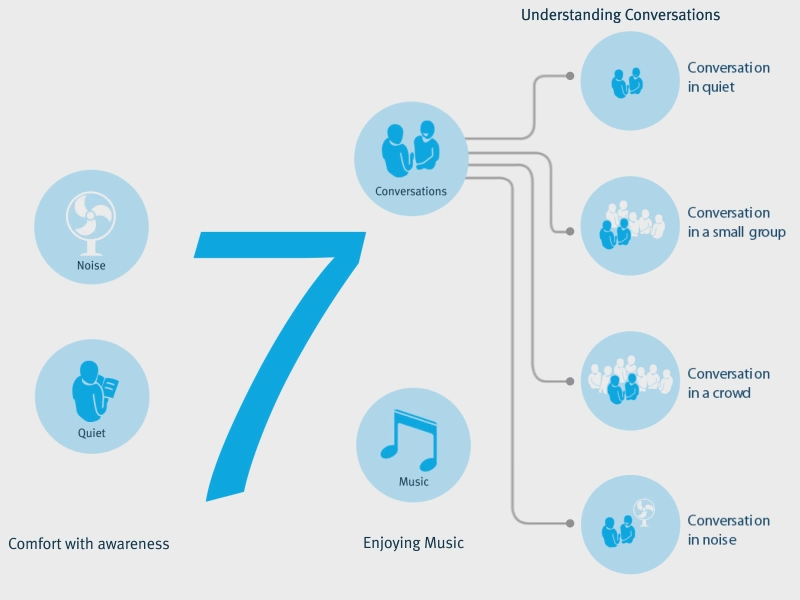
For a perfect understanding a whole team is needed
Innovations with platform North enable with the superb technologies SoundNav, Sound Conductor and SpeechZone 2 the natural sound that everyone love so much. When these three functions work together they simultaneously correct one of the main user problems: speech intelligibility.
NORTH, TEMPUS AND DISCOVER GUARANTEE:
Dynamical range of 101 dB as the widest in the industry (at North launch in 2015). It enables the systems wide range od sound capcture with no distortion, even with the loudest ones. Now even sounds as music can stay nice and clean.
Sound enters the system pure and as such it also exits, system keeps the value of signal through the processing so that the end result is more natural.
Double core processing analyzes sound while processing it. This extreme processor power enables the newest algorithms to run smoothly and process the sound on a whole different level.
Total integration of algorithms in the system enables numerous of advantages with no cost on sound quality.
With twice as much memory as the previous Era had, it if possible for the innovations, such as automatic program for 7 environments SoundNav, to work.
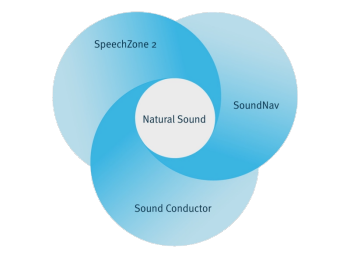
SoundNav
Because each conversation has a different background noise treating them the same would not make any sense. Automatic program SoundNav identifies and classifies the signals into seven different environments, focus remains on conversations no matter what kind of noise is in the background. If there is no conversation present, SoundNav detects if the environment is noisy or quiet. It also adapts the music for each ear.
.
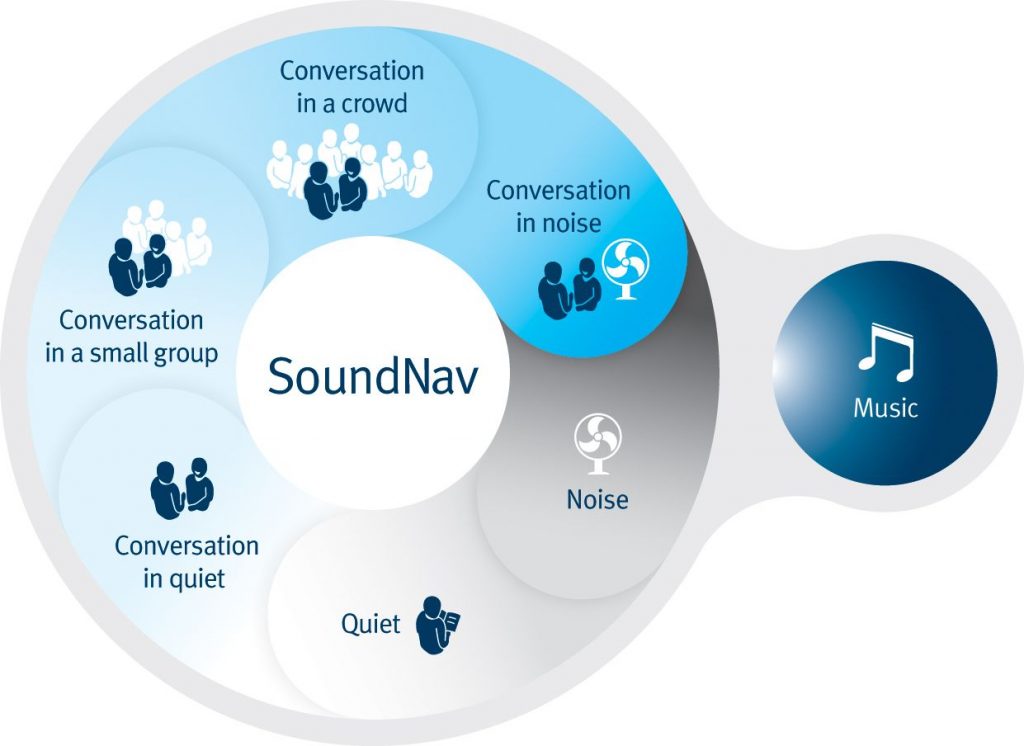
How does it benefit the user?
Users can enjoy the automatically harmonized and precise adaptations along with the natural sound, SoundNav adapts to the changes of the environment simultaneously.
Sound Conductor
The goal of this program for conversations is intelligibility. It uses the precise, intelligent classification of the SoundNav. It dynamically activates the adaptive functions and adapts to any environment of conversation, that makes the speech clearer and the sound remains natural. The correct balance of the functions is also the task done by sound conductor, it enables comfortable listening with no cost on awareness and keep the quality of the sound along with the naturality and vocals in it.
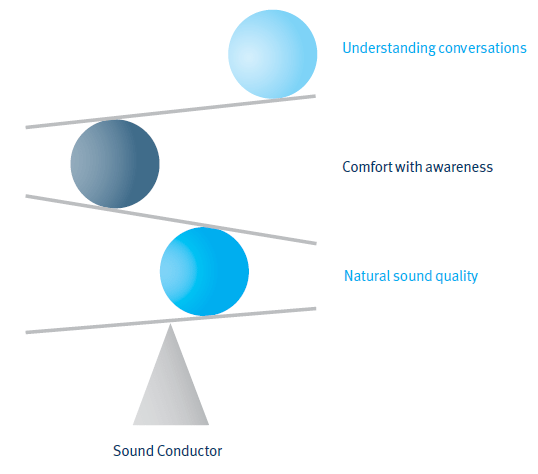
How does it benefit the user?
Users will receive clearer speech in any kind of conversation, other environments will sound more natural.
SpeechZone 2
SpeechZone 2 is optimized to work with automatic program SoundNav and Sound Conductor to get to a new level of speech localization. It turns on automatically when demanding noise is present, meanwhile it locates the direction of speech 360 degrees around user so that he or she can hear clear speech from any direction.
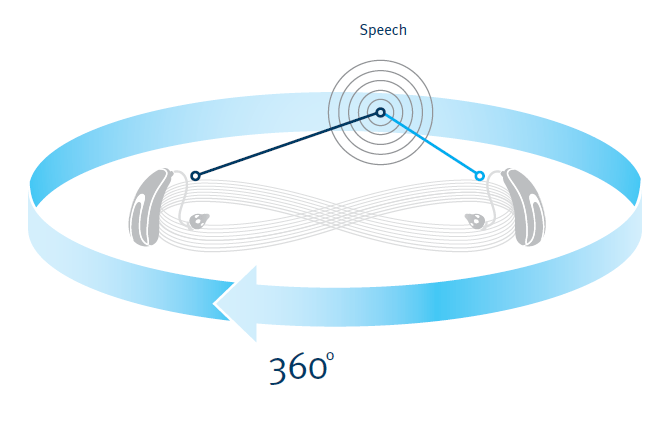
How does it benefit the user?
User will hear clear speech from any direction no matter what kind of background noise is present.
Before the year of 1996 there were only analog hearing aids present. Functions and expressions know today were not in discussion back then. All hearing aid were more or less only sound amplifiers. Any settings used would only cut or enhance the high frequencies and they worked linear. Some have had additional limiters of output sound pressure level. Most had telephone coil built, rare had directional microphones which could not work automatically.
Digitalization of hearing aids had brought unplanned development. But still prejudices around hearing aids is going strong, mostly about making unwanted sounds, closing the ear canal. Most of the prejudices are a thing of the past.
Further along let us introduce some modern-day hearing aid functions. Expressions for the functions are not standardized and each manufacturer has its own commercial name, the ones described next are based on Unitron.
Hearing aids by Unitron are fitted by hearing acousticians in AUDIO BM using the “state of the art” software called TrueFit, which is well known and appreciated among acousticians around the globe.
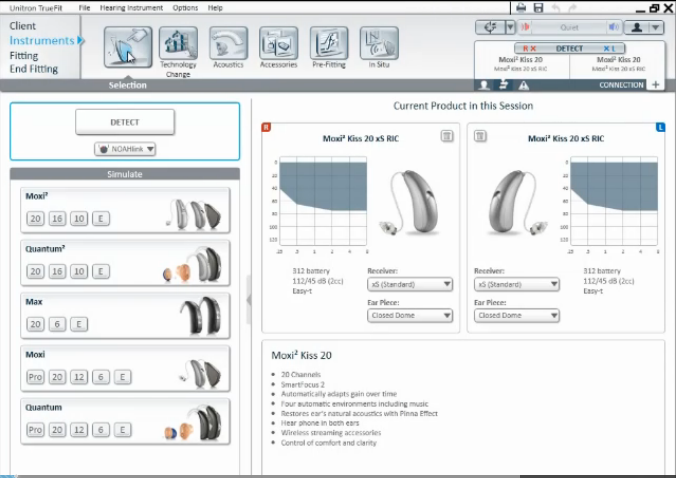
Analog hearing aids are a thing of the past. Sound transferred along amplifiers and filters. It continuously traveled from one level to another until it got to the hearing aid speaker that amplified the electrical analog signal and converted it to sound wave. The continuous travel of sound over the hearing aid was a big weakness since each filter brought some distortion to the analog signal. Also, with each cut of the signal the quality of the sound was taken because it took some clarity from the signal.
With digital hearing aids the sound is immediately digitalized when picked up by the microphones. To make it even more simple, it immediately changes into “ones and zeros”. Only this type of record can be understood by the computer. That means that hearing aids are no longer just sound amplifiers, we could say they are specially build computers. The digital hearing aid consist of processor, memory, program… – terms known from the world of computers. For ease of understanding take into consideration personal computers. Their capability is different. Support is meant for different programs (or not), they have different operating systems, the speed is different… in short, not even two computers have the same specifications. Same goes with hearing aids, each has its own capabilities, the only thing remaining the same is sound amplifying, which is not enough when hearing loss is present, for the user to be satisfied with the sound.
It is common to use channels numbers to describe the quality of the hearing aid. Although it is true that with higher number of channels the adaptation is more precise nevertheless the quality of the hearing aid is not set by it. If there are, for example, two channels in the hearing aids it means that the signal processing (not only the adaptation according to the audiogram) happens within those two. Separately the hearing aid processes the high and low frequencies. In this case there is no middle frequency signal processing which is at most important to understand speech and communicate. Unitron hearing aids have from 2 to 20 channels.
More channels mean more frequency ranges in which the complicated sound signal processing happens. More channels also mean more exact fit of the hearing aid according to the audiogram. Systems for recognizing sound environments and signals therefore work more precise and effective.
The bands are used for a specific fit of amplifications according to the audiogram. The number of channels and bands is normally the same. Channels are used to process the signals while among bands only some specific adaptations happen and that is the main difference between them.
When speaking of hearing aids, everyone heard some comments about hearing aids “hearing aid beeps, makes awful sounds, sounds unnatural, it’s too loud, it’s not loud enough”. When speaking of user troubles, these are the ones mostly present. Let’s find out why do these problems occur and how to solve them when using Unitron hearing aids.
First, we have to take into consideration that the basic fitting of hearing aid comes from audiogram. Audiogram is a graphic image of individuals hearing and is used for hearing aid fitting. Even if the audiogram is precisely made there might be some deviations that could possibly lead to troubles. Audiogram is usually done with headphones connected to audiometer. On the other hand, hearing aid is placed directly into individuals ear canal (in ear or behind the ear has to have a component in the ear canal). The difference might lead to some deviations with hearing threshold (or the comfort level threshold) measured by headphones or hearing aids – only because of the different process of measuring. These deviations might cause dissatisfaction.
At AUDIO BM we are well aware of the importance hearing has on everyday communication. Hearing aid has to give individual the sound that is comfortable to hear and does not cause any troubles while wearing. We stand strong with our belief to give each and every person using our hearing aids good, comfortable experience with the help of the newest technologies in the field of hearing aids.
For this reason, Unitron hearing aids contain a solution called IN SITU. It literally means measurement at the site of fitting in the ear canal. In other words, hearing acoustician discovers the hearing threshold with the help of hearing aids! This kind of measurement keeps the previously mentioned troubles away, because hearing is measured according to every specific setting by having a hearing aid during measurement on its place. Along with hearing threshold it is possible with In Situ to measure the comfort threshold (UCL – UnComfortable Level). That way the hearing aid will be fitted perfectly and offer a quality and proper sound for hearing.
Measurement is done quickly and easily and it is a part of every hearing aid fitting for Unitron and Sonic. AUDIO BM hearing acoustician will give you all the instructions the easiest way possible, cooperation is the same as it is with hearing measurement by audiometer. More about hearing measurements – >
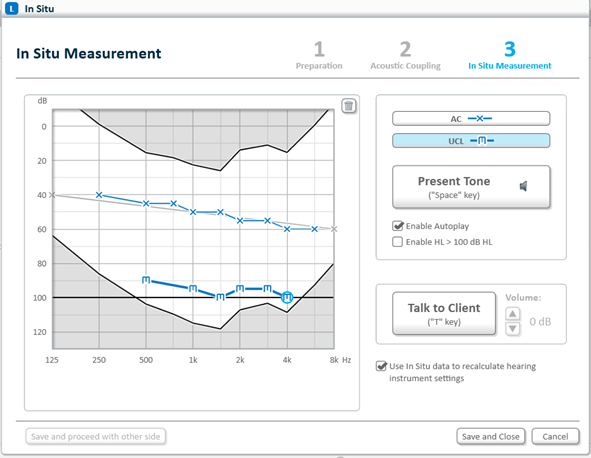
Programs in hearing aids can be switched manually, with better types of hearing aids there is one automatic program for many different sound environments (programs switch automatically). The best hearing in any kind of sound situation during hearing aid usage is with the ones that can switch the program automatically. When the individuals sound situation changes the hearing aids will adapt automatically. Sometimes users will still have the need to adapt the hearing aid by themselves. In these situations, a button on a hearing aid or a remote control can be used to manually pick the program of listening.
Most common hearing aid programs are:
- automatic program (for example quiet environment, conversations in noise, music, noise)
- manual programs (quiet environment, speech in noise, music, telephone coil, …)
Programs are in fact a very specific, purpose – tailored hearing aid fittings for a different sound situation. Because the sound environment changes a lot also the adaptation in the hearing aid has to be changed. With Unitron hearing aids the switches in programs can happen automatically.
The beeping sound of hearing aids is well known. It happens due to microphony. The amplified sound that escapes the ear canal is itself amplified in the hearing aid again – so there is even more coming out of the ear and it is amplified again, this kind of amplification loop is the reason for the beeping sound in the hearing aid. Traditionally the problem was solved by closing the ear canal as much as possible or the amplification was lower so the beeping sound was not present anymore. But it all changed when the systems for microphony prevention were presented. Systems have some variations, Unitron hearing aids are well known for their amazing feedback managing systems. Some work actively or even in connection with both hearing aids which has turned out as the most efficient.
Better feedback manager system means more stable will the hearing aid work. At this point even, telephone conversations – or closing the ear canal – does not make a beeping sound anymore. The users are much readier to wear hearing aids in public, since with the new systems there will never be a situation when the surroundings will be disturbed by the beeping of hearing aid.
Due to the systems mentioned before the ear canal does not have to be completelly closed to prevent beeping sounds. This is a great contribution to natural hearing. The individuals voice will not be a problem anymore, when the ear canal was closed it sounded strange, hollow, boomy. The ear canal is free so it can breathe. The limitation is only the hearing loss. If it is more profound than it is considered ok by the tests it has to be more closed. Open fitting is possible with behind the ear hearing aid types which can get really small.
Open fitting means that the ear canal is not fully closed. Listening is more natural. Sound can travel to ear naturally while hearing aid amplifies only what cant be heard by ear. If the ear canal has to be closed all sounds will travel first to the hearing aid and then into the ear. Better is the feedback manager more chances are the open fitting will be possible. Ear canal is radiant and there is more comfort while wearing.
The microphones task is to accept the sound wave and transform it into electrical signal. If the hearing aid only has one microphone the sound perception from both sides will be the same (omni sound perception). When there are two microphones build in the hearing aid there is a different direction caracteristics of sound acceptance (directed sound acceptance). There could also be some better versions of microphones that will change the directionality of sound capture automatically. The less complicated versions will perceive the whole spectre of sound either directional or omni. Better versions are able to adapt the directional caracteristics also for different frequency ranges (multiband).
Directionality of sound capturing is important for listening. Nature gave us ears for that prupose. The harder the sound situation (for example noise in the background) more important it is that the hearing aid don’t capture the sound from each direction. Users can focus on the sound coming from the direction of the speaker, background noise is lowered before it enters the hearing aid.
When there is behind the ear type of hearing aid used the microphones are not placed naturally but behind the ear. The ear does not play the natural role of capturing the high frequency sounds anymore which are at most important to understand speech. If the hearing aid has an option of “pinna effect” the microphones could work towards capturing the high frequency sounds even better just as the ear would.
Sound is perceived more naturally as if the microphone would be placed in the ear canal. The intelligibility of the speech is better, specially in a noisy environment or when there are multiple speakers talking.
Each hearing aid along with a microphone also has a speaker. In the past it was always built inside the hearing aid. If the hearing aid is behind the ear type the sound flows over the tube to the earmold where it enters the ear canal. That path is the longest before it leaves the earmold and meets the eardrum. The abreviations in the title (RITE – Receiver in the ear, RIC – Receiver in canal …) stand for the hearing aid types where the speaker is no longer built in the hearing aid, it is located in the ear cap that is placed in the ear canal.
The change in the location of the speaker brought many advantages. Some of the most important are:
- sound closer to eardrum
- shorter path of sound to the eardrum
- with shorter path comes better acoustics. Sound is clearer and more natural
The housing of the hearing aid is smaller, because there is no longer speaker using the space inside of it.
The function of self learning tracks any manual interventions of the user on the hearing aid when the volume is changed or for the system of volume control and comfort (SmartFocus 2). Eventually the hearing aid will record the most used settings and change the starting volume or the function of SmartFocus 2 inside the range that hearing acoustician had set. If, for example, hearing acoustician fitted volume of 5 steps up and 5 steps down and if the user always moves it three steps down the hearing aid will keep it in the memory and eventually start with the volume three steps lower.
Users won’t have to get to the hearing acoustician just to have volume adjusted because the hearing aid will self learn to work at its best according to the needs of the user.
Some hearing aid users are already adapted to the sound. Others who get the hearing aid on the ear for the first time can have several problems with hearing different sounds. Over the years of living with hearing loss many sounds might have been forgotten. Also, the users voice might be a problem because it changes and becames louder. If the hearing aid has an option of automatic adaptation control hearing acoustician can set the strategy of adaptation at the first fit with which the hearing aid will (for example each week) boost the fit a bit more – all with consideration how fast can the user adjust to new sounds.
Users begin listening with hearing aids at the lower level of adaptation as it would have been if no adaptation would have been needed. Over the time hearing aids lift the level of adaptation as long as its needed to get to the optimal value.
In case of sudden loud noise, the hearing aids will automatically make the loud noise (such as doors slaming) appropriately lower without causing any discomfort. As soon as the loud impulse sound is gone the hearing aids return to normal so that the sound informations following will be there for the user to hear.
DuoLink enables any change of volume, program, comfort with SmartFocus 2 on one hearing aid to be transferred to second hearing aid on the other side. Not only that, the hearing aids help each other with the information received about the sound and environment. Procesors chech the data collected by both hearing aids and automatically and optimatelly balance both hearing aids for the environments in which the user is located.
Hearing aids are wirelessly connected. Any change of program or volume is transferred also to the other side. Balancing two hearing aids becomes simple and harmonized. Due to more data about the hearing environment the systems working against unwanted noise and sounds work more precise, intelligibility of speech in noise gets better and localization of sounds easier.
Function of listening to telephone conversation on both hearing aids makes it possible for the phone to be held on one side and hear the sound coming from it clearly into both ears. Some types of hearing aids enable that with no additional gadgets. Function can operate if the hearing aid supports wireless hearing aid connection.
Even those with normal hearing aren’t able to hear the phone in both ears, so here it is some sort of advantage.
Telephone coils detect electromagnetic energy. It is an additional option in hearing aid or speech prosecor of cochlear implant can help listening on public places that are equipped with the system of induction loop (hearing loop) or ease telephone conversations – for the pones that have electromagnetic field in the speaker wide enough.
Wherever you see the sign with blue ear picture and a letter T it means the place has an induction loop and you can use the telephone coil in your hearing aids.
All you have to do is switch the program on your hearing aid to “T”.
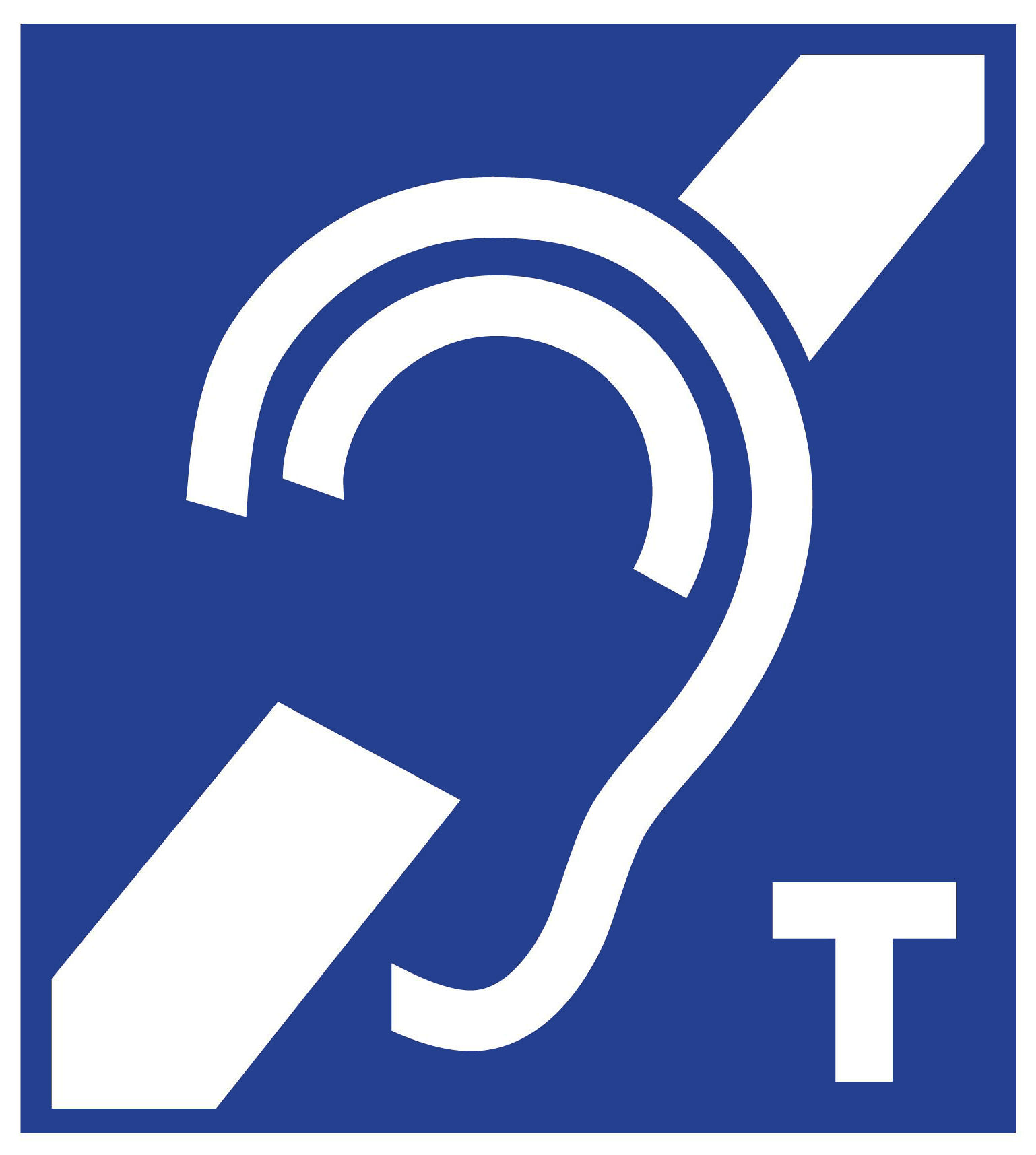
Induction loop (hearing loop) is not built in the hearing aid or the speech processor of the cochlear implant, but let us introduce its functionality.
Induction (hearing) loop is a wire around the room, connected by a special amplifier to a sound source. Due to the loop hearing aid and cochlear implant users with built in telephone coil when they switch to “T” program can clearly hear the sound from the source. With this kind of listening the problem of distance, noise and echo, that mostly cause trouble hearing and understanding over TV and sound systems are down to zero. The wire normally runs on the ground so it can not be seen.
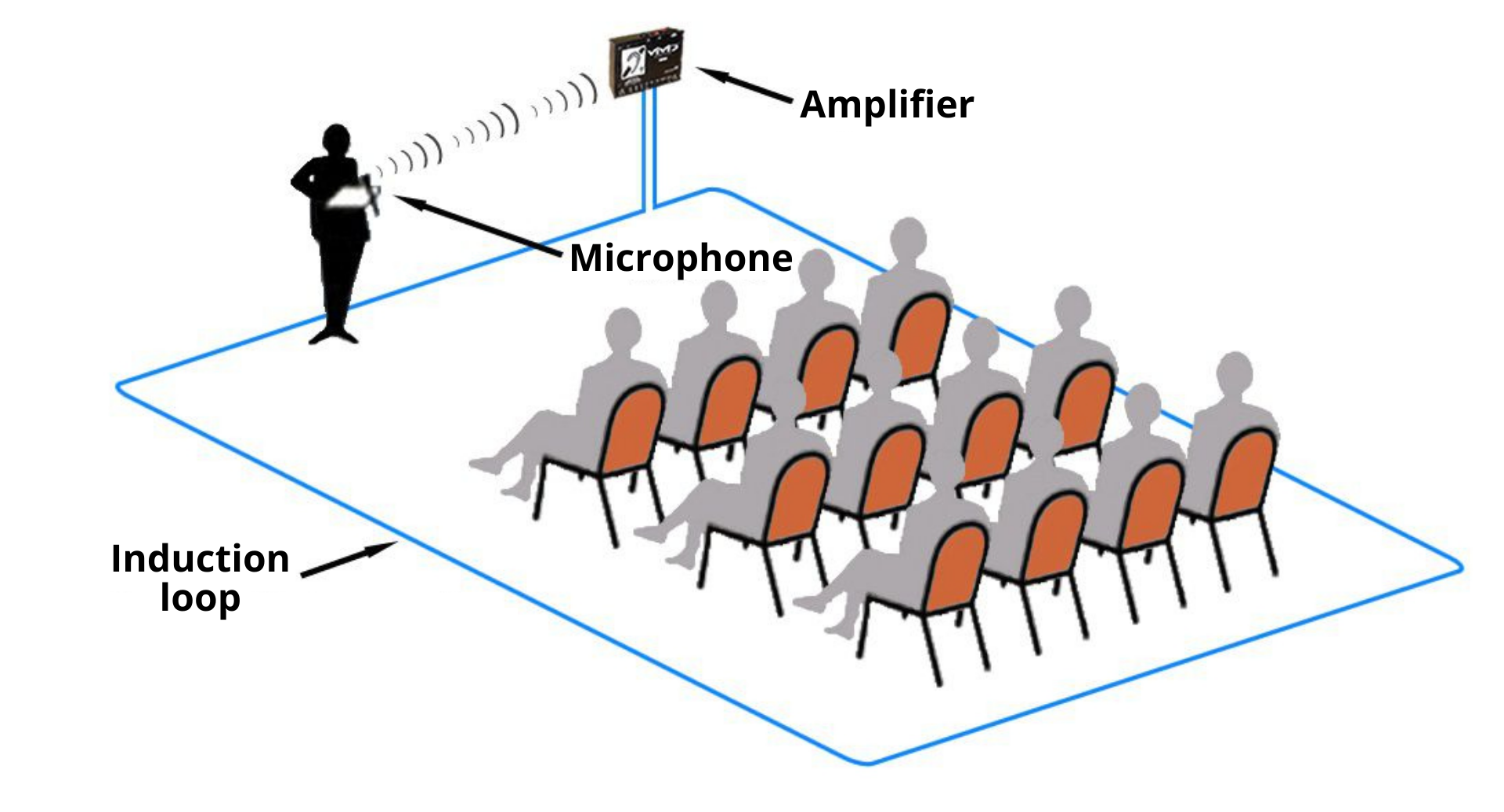
Example of induction loop use on public place:
With the use of induction loop we can prevent disturbing echo, noise, beeping and other unwanted sounds that might appear in the hearing aid or cochlear implant while listening to the radio, TV, sound from the microphone or on noisy public places.
AUDIO BM offers several induction loop systems for personal or professional usage >>
If the hearing aid has easy-T function it will automatically switch to the program for telephone conversation when the phone gets near the hearing aid over the telephone coil (or for example binaural telephone). When the program is switched on user will hear a short melody to let you know that the program for telephone conversations (easy-T). When the telephone conversation is over and the phone is moved away from the ear it will be switched back to universal listening.
While telephone conversation is happening there is no need to manually change anything. It might not be easy to find the switch on the hearing aid or remote control and answer the call at the same time. It has to be done quickly. The function easy-T makes it all automatic, fast and at the moment when it is needed.
Extensively:
Telephone conversations with hearing aids
The users of hearing aids find telephoning problematic. They eather don’t hear the other side well or the speech is not intelligible. Also, the hearing aids could beep because the microphony happens when the hearing aid is covered with telephone.
AUDIO BM has a simple solution! Introducing magnet that can simply be attached near to the speaker of the telephone. Whenever the hearing aid is close to the telephone it will switch to the program specially fitted for telephone conversations. Users don’t have to manually set anything prior the conversation. The speech from the speaker will be loudg enough, intelligible and with some hearing aids it can also be heard on both sides! Telephoning is easy and resembles just as if you would be using it without hearing aids because the fit is easy and automatic in a moment when it is needed.
How is that possible? Unitron and Sonic hearing aids has a built-in magnetic field sensor. When the magnetic field close to the hearing aid is strong enough the automatic switch to telephone conversation program happens. This function is called easy-T. Contact you hearing acoustician to get the fit that would suit your needs and try it out.
Specially fitted telephone conversations will enable:
- more telephone speech volume and active prevention of microphony while the phone is near the hearing aid
- switch on the telephone coil and possibly even turning off the hearing aid microphone so the background noise doesn’t disturb the conversation
- transfer of the speech from the telephone on the hearing aid for both ears, to enable easy telephone conversation with hearing it on both sides
Where to attach the magnet? It has to be taped on the telephone part that is the closest to the hearing aid.
Telephone conversations are a part of everyday life. Telephones are with us basically with us on every step. Speacially fitted settings for telephone conversations are a great solution for hearing aid users due to how comfortable and quality they bring to listening over the phone. Many individuals with hearing loss tend to give up on telephone conversations stating it could be too complicated or manually taking to much time to get the hearing aids switched into the right program.
With Unitron and Sonic hearing aids we wish to enable everyone with hearing loss as intelligible and undisturbed conversation as possible – even through the telephone. With the use of the magnet it could be even easier.
SmartFocus2 enables balance between comfort and clarity. Hearing aids can automatically adapt more clarity of the speech, with other words they enable more comfort listening in a noisy environment. With those situations the system adapts simultaneously. Intensity of the SmartFocus function can be changed using remote control or on the hearing aid if it supports this kind of adaptation.
With greater intensity of SmartFocus function the hearing aids adapt and focus more on the clarity of speech. By lower intensity of the SmartFocus function the noise in the background lowers and listening becomes more comfortable.
Unitron and Sonic provide tinnitus masker which is basically broadband sound generator. It enables theraphy with enriched sound that could be used to soften the individual’s tinnitus by the use of special program set to the needs. It is based on enrichment of sound stimulation that helps the individual to turn the attention away from the tinnitus.
Sound enrichment along with professional counceling is a verified approach to control tinnitus.
Audible indicators inform users about the certain stages of hearing aids (battery information, changes of volume and programs…).
Audible indicators are in great help for the users, they know exactly how the hearing aid is working.
Hearing aids automatically log several data that can help the hearing acoustician at the check up with fitting and counceling. From the data log can also be seen how many hours per day the hearing aids have been used, how many manuall volume adaptations and program switches had been used.
Logg it all – logging of all information, exclusive with Unitron (ever since 2015)
Previouslly mention data logging is a function able with most hearing aid manufacturers. With Unitron and Sonic hearing aids is enabled with any hearing aid (even the basic ones). Hearing acousticians use the automatically saved data to look into the need of listening for any individual as for how many hours per day hearing aids have been used, keeping track with how many times user have changed the volume or program for listening. With basic data logging there is no log about the listening environments in which the hearing aid has been used or is enabled only for the higher series. To gather the information about the listening environments hearing acoustician has to rely on the information given by the user. Because this kind of information might not be objective it is hard to figure out if it suits the actual situation.
Log It All is a new revolutionary function in the industry of hearing aids and is available only with Unitron hearing aids based on North platform. It includes the traditional data logging along with gathering the information about the sound environment where the user is located. This can get us an objective insight in the user’s life style and a great help with choosing the correct technology level along with the most optimal fitting of hearing aids.
Tradicional approach
Tradicional way of data logging helped with objective monitoring how much time the user has actually been using the hearing aid. This is at most important with new hearing aid users. The result of time using the hearing aids is helpful also in times when the user states that the battery does not last as long as it is expected. If the data logging shows that the hearing aids has been used for 24 hours it means that it has not been turned off at night. Tradicional approach is good to understand the basic needs of the user. But to get a better understanding about the usage in different sound environments acoustician will need informations from the user which might be subjective.
Modern technology in the Unitron hearing aids that are based on the North platform enable, for the first time in the industry of hearing aids, objective information on any level of technology.
Real life, real data
Log It All is a function available with all hearing aids that support the North platform. Because it still works along with the traditional way of collecting the data so all the information is stored along with the profound insight of the users needs by adding Log It All.
Seven pronounced hearing environments
Log it all collects all data from any sound environment in which the user is located and sorts them into seven SoundNav automatic programs: conversation in quiet, conversation in small group, conversation in crowd, conversation in noise, noise, quiet, music.
All technology levels
Tradicional approach of data logging collects only the information that are supported by the technology level of hearing aid currently used. On contrary Log It All technology logs and shows data within SoundNav technology no matter which environments are covered with the chosen sound environment. Hearing acoustician can objectively see how the current level of technology can deal with the sound environments that it was presented to.
Real hearing needs
Hearing needs are different from user to user. Function Log It All shows these needs in a clear image which helps hearing acoustician and user to find the best new technology that will suit the user most.
Log it all spreads the information specifically based on the users sound environments in a more structural and detailed than it was with the traditional data logging. On the graph a bit lower is shown how two users that wore the same level od technology hearing aids were wearing them withing three weeks. The graph shows traditional data logging that divide the hearing environments only in two groups: quiet and noisy. Both users have similar usage patterns in similar environments at the same technology level.
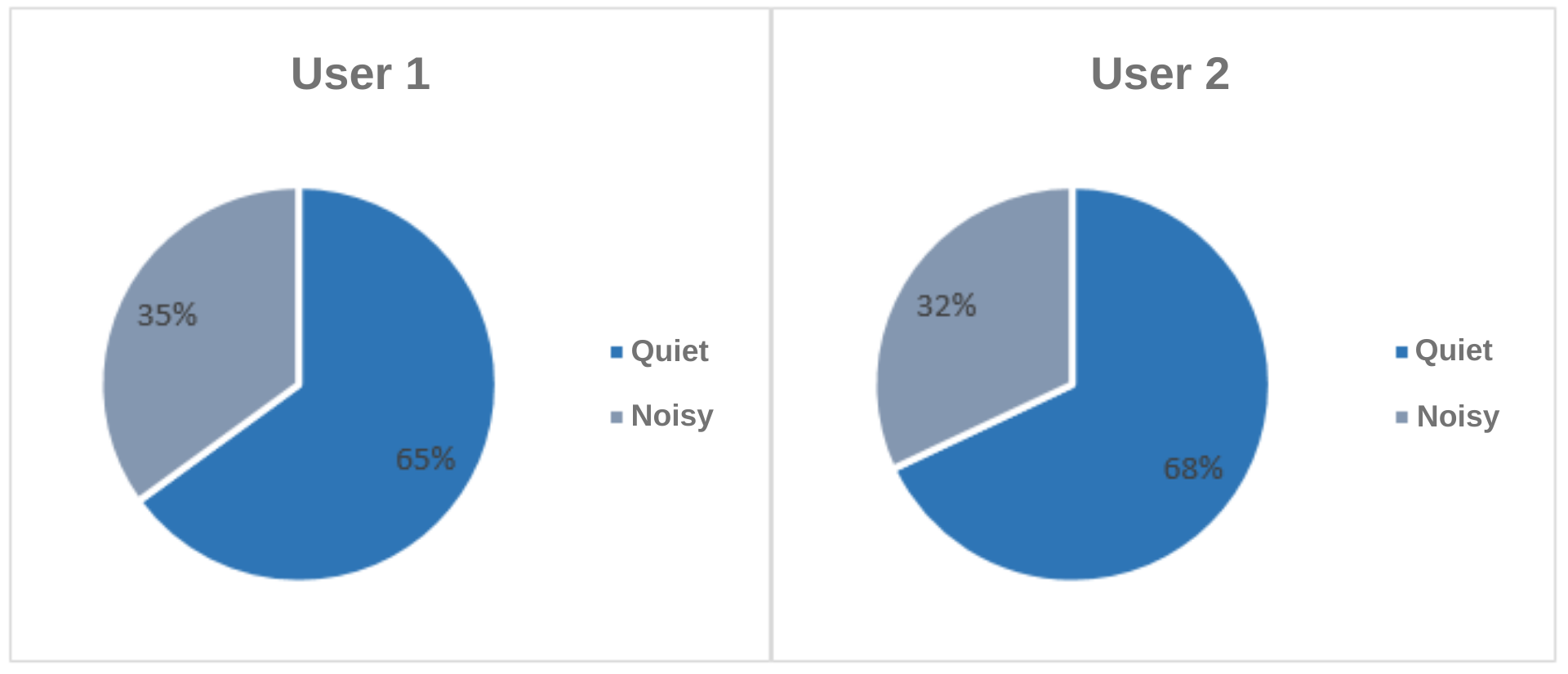
Function Log It All in the graph here shows a completely different picture. Graph clearly shows the needs of each user:
- Use is shown for each user by all seven SoundNav environments, which is more than the present hearing aids technology level covers. Data precisely show the users active listening environments.
- In case the users would be buying new hearing aids the difference in gathered data would show that they need a hearing aids of different technology levels which could not be seen with tradicional data logging.
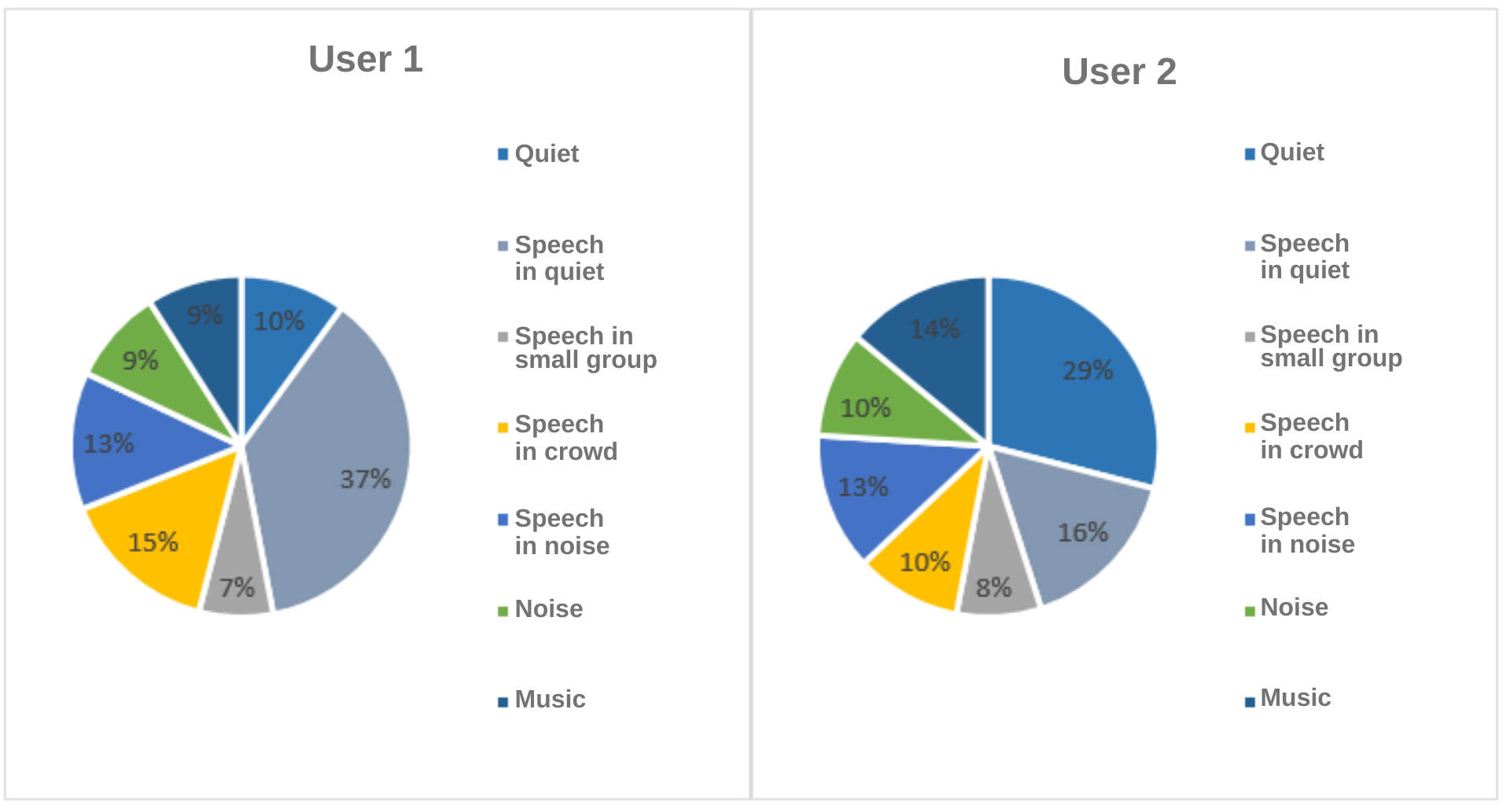
Log It All is an exclusive function provided by Unitron hearing aids.
For more information or free of charge test of hearing aids visit any of AUDIO BM hearing centers.
Sonic hearing aid functions explanation
SPEECH VARIABLE PROCESSING
Technology of sound processing that copies the sound analizing and adapting in the way human ear does to receive the most natural and pure sound possible.
ENVELOPE FOCUS
Appropriate for users older than 75 years where the brain processing is slower and the hearing loss exceeds 70dB at frequencies 4kHz and 8kHz.
PHONEME FOCUS
For users younger than 75 years and when hearing loss does not exceed 70dB.
FREQUENCY TRANSFER
Technology that relocates high frequencies in the range of low and keeps them placed in the original spot.
SPEECH PRIORITY NOISE REDUCTION (SPNR)
Helps with the intelligibility of speech by monitoring input sounds at every moment, lowers the background noise and keeps all the elements of speech. The biggest advantage of the system is its speed. It works based on fonem analyze.
ADAPTIVE NOISE REDUCTION
Only available in PEP hearing aids. It is a bit slower, not so efficient and precise technology ad the SPNR is. Main difference shows when there is not so much emphasis on speech.
WIND NOISE REDUCTION
Technology that enables comfort also in outside environment with no amplification of the noise from the wind with whole frequency range being muffled when needed.
SOFT NOISE REDUCTION
Helps to prevent the soft but unwanted sounds as the sound of the fan or the fridge sounds to be disturbing the user by lowering them without any effect on important speech signals.
IMPULSE NOISE REDUCTION
Lowering the impulse noise such as glass breaking, pen falling on a hard surface, cutlery noise etc. without changing any of the sound that consist of speech.
FIXED OMNI
With every Sonic hearing aid in easy environments, no background noise that have to be processed by hearing aid – sounds from each direction are at the same amplification.
FIXED DIRECTIONAL
With every Sonic hearing aid. Focused only on the amplification of the sound from the front and not so much from the sound coming from the back. Example, at the dinner: Focus is on the speech of the person sitting next to us not on the conversations all around.
ADAPTIVE DIRECTIONAL
System analizes sounds with an amazing speed of detecting the loudest sounds. It is focused on the specific sounds in a certain frequency range. Best for environments where the change of sounds is dynamic such as at the office or in the city.
HYBRID ADAPTIVE DIRECTIONAL
Resembles healthy ear canal. Appropriate for users manly passing time outside: low frequencies are not adaptive but always on OMNI. All other frequencies are adapting on ADAPTIVE DIRECTIONAL.
ADAPTIVE FEEDBACK CANCELLER
With hearing aids PEP standard version is available, with others advanced. Modern system very quickly (in 5 miliseconds) removes unwanted sounds before we are able to hear them. There is no beeping from the hearing aid present so the listening remains comfortable.
VOLUME AND PROGRAME CHANGE
Adjusting the volume of sound using the buttons and changing listening programs on the hearing aids.
ENVIRONMENT CLASSIFICATION
Sounds from the surroundings are classified into five different environments: speech in noise, speech in quiet, noisy only, quiet only, wind. Hearing aids by the help from Binaural Coordination synchronizes the detected environment in both hearing aids and adapts, optimizes the sound of listening environment.
NON-TELEPHONE EAR CONTROL
Technology cooperating the Binaural Coordination system. Program automatically recognizes on which side we listen to the telephone conversation and lowers the volume or shuts the microphone on the other side so that the background sounds are not disturbing the telephone conversation.
DATA LOGGING
Enables detailed fitting of hearing aids according to the past usage information collected.
DATA LEARNING
Enables automatic learning for hearing aids about the reguested sound volume, program switch and automatic switching on the favorite settings.
Aditional accessories are presented as several different devices that can work along with hearing aids and other communication-oriented devices (for example telephone). That way the listening can be better and the setting the hearing aids easier.
Some of the additional supporting devices:
Remote control
Almost every Unitron hearing aids could be set with the help of additional Unitron remote control (available in couple of versions). Aditional remote control enables switching between different listening programs, volume control or setting of SmartFocus2 (depends on the version).
The most important functions can be always at hand. Normally remote controls enable at least volume control and manual program switching. Better versions have options as split control of the hearing aids, wireless conection with telephone or another sound source.
Remote control also enables manual control over the hearing aid even if the aid does not have a manual option of adjustements on itself. With remote control the adjustements are discret and precise.
uDirect and uStream
uDirect and uStream are both additional devices for hearing aids that support wireless connectivity. It enables the easy hands-free access to devices that have connection as Bluetooth enabled such as mobile phones. uDirect comes together with audio cable that can be connected to devices such as mp3 players, tablets, computers and it can be used also for wireless adjustements on the hearing aids.
uDirect and uStream enable wireless connectivity and can be used also as a remote control for hearing aids.
uTV
uTV id used together with uDirect for sending the sound from the TV directly in the hearing aids. uTV can also transfer sound from music players, computers and other sound sources.
Transfer of the sound from a chosen audio source (for example TV) runs in stereo, high quality and with basically no delay.
We have listed a lot of functions and solutions but far from everything. To repeat, hearing aids in modern days are specially made computers with ongoing development. The goal is to enable the users as natural and quality listening as possible and giving them a chance to communicate which is the main role of hearing. UNITRON and SONIC in many solutions stand out – for quality and accessible price range.
With hearing aids available at our hearing centers, the sound amplifing is not everything.
Users that have tested the modern-day hearing aids are happy with their decision, these hearing aids will give you much more than just enhanced sound. It will take you back into the world of communication and the joy in the world of sounds!
Read more about hearing and hearing aids.
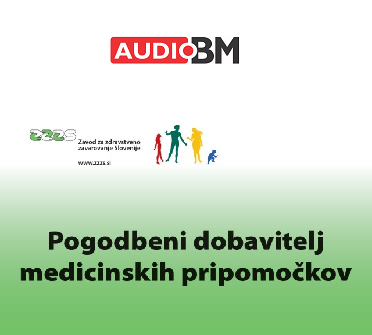
AUDIO BM hearing centers are contract retailers for Health Insurance Institute of Slovenia ZZZS.
We accept hearing aid referrals from all ENT clinics. Choosing a hearing aid supplier is your FREE choice. Before buying a hearing aid, get to know and try out one of ours.

Many customers confirm our commitment to providing help so you can again hear and live better.
At AUDIO BM we work professionally and with our heart. We provide excellent service and the latest hearing aid models to meet all your needs and suit all generations - even at no extra cost.
WE REPRESENT WELL KNOWN AND RELIABLE TRADEMARKS
